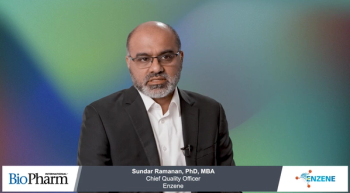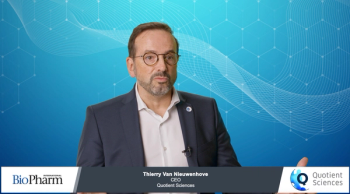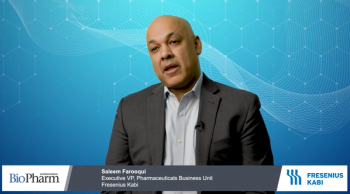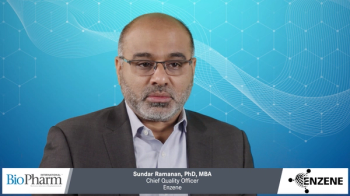
Mastering Analytical Testing for Biologics Products
Scientific experts Katarzyna Darmochwal, PhD, and Carmen Sweeney, PhD, discuss the latest regulatory expectations for the analytical testing of biologics products. They explain why regulatory success depends not only on compliance, but also on the precision, reliability, and depth of scientific understanding behind every test method.
Understand the latest regulatory expectations for the
BIOPHARM INTERNATIONAL®: What are the latest regulatory expectations for analytical testing of biologics across different stages?
KATARZYNA DARMOCHWAL, PhD: Before I answer, I would like to say a few words about analytical test methods. Analytical test methods are various techniques used to identify the physical and chemical characteristics of a given product. Any analytical test method must fit for its intended purpose before it’s used routinely. The usual process of demonstrating this suitability takes place by developing qualification, optimization, and validation studies, or even, if required, verification.
There are many regulatory documents issued by the Food and Drug Administration (FDA) and European Medicines Agency (EMA) for biological products. The most well-known document, USP <1225> titled Validation of Compendial Procedures, served as the foundation for ICH Q2 titled Guidance on Validation of Analytical Procedures. The intent of both these documents was to provide guidance to the industry about how to validate different types of analytical test methods. Unfortunately, they do not provide a framework that allows users to reliably understand and control sources of variability. Due to this observation, a life cycle management process was developed for analytical procedures and described in different documents like ICH Q8, Q9, Q10, and also in Q11.
In the last few years, analytical method development and validation processes are being reshaped by technological breakthroughs, strict regulatory demands, and market imperatives. Accelerating time to market intensifies as pharmaceutical pipelines expand and patents expire. Simultaneously, global regulatory bodies impose rigorous standards, demanding analytical methods ensure product consistency and safety. Guidelines such as ICH Q2R2 and Q14 set the benchmark for method development and validation, emphasizing precision, robustness, and data integrity.
There is a global harmonization trend of analytical expectation to align validation efforts across different regions. The aim of this harmonization is to reduce complexity and ensure consistent quality while meeting diverse regulatory requirements. The critical aspects of any analytical test method are data integrity and governance. Following the ALCOA+ framework allows data governance to eliminate discrepancies and ensure transparency and regulatory confidence.
A Quality by Design (QbD) approach has been introduced in the method development of analytical test methods. This includes the foundational principle of QbD and design of experiments. There are also other strategies suggested for validating analytical methods—for example, risk-based validation to target high-impact areas, optimizing effort and minimizing over testing. This strategy reduces compliance risk, aligning resources with critical method needs. ICH Q2R2 and Q14 propose a life cycle approach, integrating development and validation with data-driven robustness. The life cycle validation strategy unfolds in three phases: method design and feasibility, qualification followed by validation, and continuous performance monitoring. This staged approach ensures sustained method fit for purpose for the product across different stages of development.
BIOPHARM INTERNATIONAL®: How do you identify and monitor those critical quality attributes (CQAs) for biological products?
KATARZYNA DARMOCHWAL, PhD: To answer this question, we first need to explain what CQAs are. According to ICH Q8R2 guidance, CQAs are physical, chemical, biological, or microbiological properties or characteristics that should be within an appropriate limit, range, or distribution to ensure the desired product quality. Typical CQAs are applied not only to biologic products but also to cell and gene therapy products.
However, this definition refers only to potential patient impacts, which means that not all quality attributes are considered critical. The size of the drug, for example, is a critical attribute at the commercial stage and marketing stage, but it's not critical to safety or efficacy. On the other hand, impurities or degradants in injectable products can lead to adverse events and negative patient consequences. Therefore, they are classified as critical.
Identification of CQAs is a very important step in the development of biological products. Sometimes literature can be used as a good source of information to identify these CQAs in early stages. This identification is further related to process characterization because all identified CQAs need to be assessed for their variability within the manufacturing process. The most common approach to identify quality attributes is based on product-related or process-related substances or impurities and is used to design specifications that would maintain the analytical profile. However, the more scientific approach seeks to identify product quality attributes that are critical for the safety and efficacy of the product. This process allows product quality control to be built into the manufacturing process.
It is worth highlighting that identification of CQAs starts early in the development process and evolves to different stages. It's finalized at the later stage of commercial process development. Also, I would like to mention that some attributes are determined as obligatory CQAs as per standard expectation. For monoclonal antibodies, CQAs are divided into product variants, process-related impurities, product-related impurities, obligatory quality attributes, raw materials and leachable compounds. By grouping these attributes, some level of simplification is allowed that guides the criticality assessment approach depending on the nature type of the attribute’s categorization.
One of the most common approaches to identify CQAs is risk assessment. This is based on the quality risk management guidelines which are outlined in ICH Q9, including a scoring tool. While there are variations in the exact approach and specific scoring tools used by different groups, the common practice is to employ a scoring system based on two factors: impact and uncertainty. This type of assessment is performed at key points during process development, with studies designed to improve product knowledge and drive down the uncertainty. For example, the uncertainty is very high when no information is available about the product and very low when the impact of a specific product is already established in clinical studies.
Best practices for monitoring CQAs include using control charts for each quality attributes, applying statistical control limits, comparing current batch trends with historical data, and investigating early out-of-trend results through a formal process. These practices are commonly used at Charles River.
BIOPHARM INTERNATIONAL®: How does your investment in technology automation and digital systems enhance client data delivery speed and reliability?
CARMEN SWEENEY, PhD: At Charles River, our digital transformation has and continues to be guided by a very simple principle where speed, reliability, and ultimately transparency matter most in delivering data that our clients can depend on. We are digitizing our operations to reduce the reliance on paper, hopefully eliminate inefficiencies, and give our clients real-time visibility into their projects. This ultimate foundation will then hopefully enable us to bring therapies to patients faster while also improving compliance, consistency, and trust in every result. In recent years, we have invested in a global digital foundation. Today, our laboratories operate with standardized systems for managing samples, quality processes, training, equipment, materials, and documentation. Apollo™, which is our client portal for biologics, extends this vision externally by giving customers near real-time access to their samples, the status of them, their reports, and collaboration tools. These platforms ensure that critical steps in the testing and manufacturing journey are not only digitized but harmonized and accessible globally.
At the same time, we are still in the early stages of this, and we are trying to complete this foundation. The laboratory execution system (LES) is a key element and will be the most crucial step to eventually connect and orchestrate all the systems together. I suppose the next phase of our journey will ultimately be about connection. While the foundation is being finalized, systems often still operate in isolation.
Our focus now will be on integrating these platforms into a seamless digital ecosystem by linking data flows across the lab and enabling review by exception. We will not only accelerate turnaround times but also unlock advanced opportunities such as AI-assisted insights and ultimately predictive analytics. For clients, this translates into faster data delivery, fewer errors, and greater reliability—ensuring confidence in not only the results but also a smoother path to market.
BIOPHARM INTERNATIONAL®: What strategies help accelerate analytical timelines without compromising compliance?
KATARZYNA DARMOCHWAL, PhD: Accelerating analytical method development can significantly shorten drug development timelines and support early process scale up and validation. However, this can happen only if high performance and regulatory compliance are maintained.
Charles River combines scientific expertise and advanced technological approaches to deliver robust, phase-appropriate methods that evolve from early phase through commercialization. It is very important to mention that the process of developing analytical methods must be robust; unfortunately, this is rarely straightforward due to complexity. Each method must be adapted to the certain type of molecule, its formulation, and the phase of development. At each phase of the product, the method must remain fit for purpose while aligning with the current regulatory expectation.
In practice, this means that analytical method development should progress in parallel with process development. This involves coordination between different teams including the quality team. This complex process needs to meet good manufacturing practice (GMP) requirements for method qualification, validation, and life cycle management. One of the expectations is to implement design of experiment.
This minimizes the number of conducting assays while increasing the generation of results, demonstrating robustness across operating conditions. This strategy allows us to not only work faster but also smarter. When robust methods are developed as early as possible and are efficient, this helps accelerating the qualification and/or validation of these methods. Streamlined analytical development directly supports method validation by ensuring that critical test methods are in place when production needs them. In contract development and manufacturing organization (CDMO) environments where production timelines are extremely tight, having methods ready for batch release and in-process testing is absolutely essential. In the process of accelerating analytical timelines, different tools can be used. For example, QbD can be employed, which can be supported by the right digital infrastructure.
Charles River is constantly adopting new state-of-the-art equipment and analytical technologies to reduce the time of analysis without compromising compliance. However, the equipment needs to be operated by analysts who receive continuous training not only on executing the procedure but also on regulatory expectation. Analysts at Charles River are encouraged to understand the aim of the method and procedure they are executing.
To summarize, the combination of modern equipment with a team of experts ensures that accelerated timelines do not compromise compliance. Successful accelerated analytical timelines are based on clear continuous communication not only within Charles River but also with our clients.
BIOPHARM INTERNATIONAL®: How do Charles River analytical testing sites collaborate globally to deliver consistent, phase-appropriate testing?
CARMEN SWEENEY, PhD: Over the last number of years, we've worked very hard to operate in a collaborative and harmonized manner across our multiple sites. We've done this through regular and open communication and meetings with focused technical groups. Fundamental to the success of delivering consistent and high-quality, phase-appropriate testing was the establishment of our newly issued Charles River policy on method qualification, validation and transfer, and the implementation of this policy globally at all our sites within the manufacturing division of Charles River. The reason why we felt the need for this was that we realized that all of our sites had their own internal procedures for method development, qualification, validation and transfer. Also, there were different interpretations of the guidelines, which resulted in differences in the definitions and nomenclature used across the sites. So, we soon realized that we needed a consistent and harmonized approach to the method development, qualification, validation, and transfer not just for ourselves but also for our clients who can and do work with multiple sites across different continents.
This policy now addresses how we will perform all method development, qualification, validation and transfer activities which are needed for all GMP QC release and stability testing. Specifically, this policy provides clear definitions and nomenclature to be used by all the sites, and it ultimately defines our processes. For example, it states when qualification is necessary during a transfer versus going straight with a validation, or at which stage of a drug development process validation is necessary.
KATARZYNA DARMOCHWAL, PhD: I would like to add that this policy was very helpful for us in harmonizing the work between sites. Of course, the definition was the first step to identify what we need to do next. So, this policy allows us to meet with different sites, with different subject matter experts, and design the study according to policy, method transfer, qualification, and validation. This also helps us streamline the process and ensure tasks like method transfer, qualification, and validation are very comparable between different sites. It is very critical that clients, no matter which site they are talking with, are receiving very similar work based on design and quality. We are constantly improving by discussing with subject matter experts and our quality group to make sure we are all aligned with the strategy and design.
For more information about this discussion, please click
Newsletter
Stay at the forefront of biopharmaceutical innovation—subscribe to BioPharm International for expert insights on drug development, manufacturing, compliance, and more.





